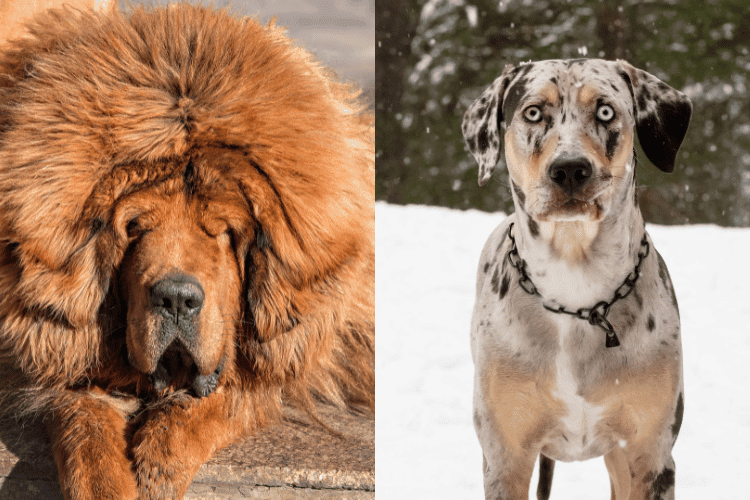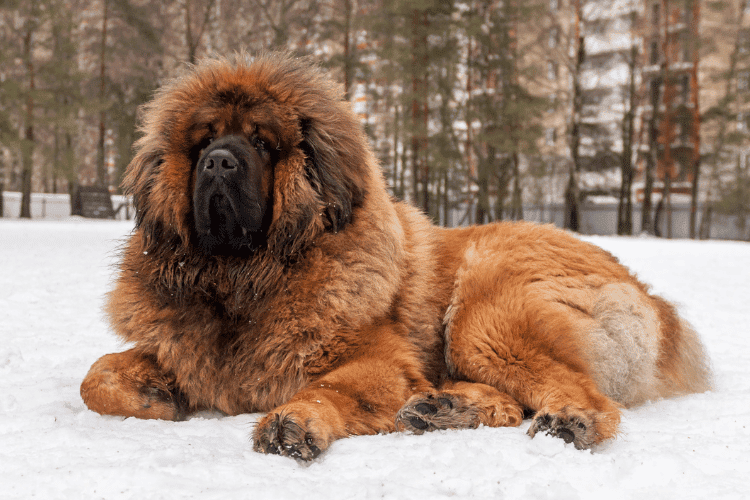A Mastiff Catahoula mix, also known as Mastahoula, is a cross between Mastiff and Catahoula Leopard dogs. Naturally, the result is a combination of traits from both parents.
Looking at the characteristics of both breeds will give you a pretty good idea of how varied the Mastahoula offspring can get. One thing is for sure, though, the Mastiff Catahoula mix is smart, affectionate, and loyal.
Are you considering this breed? If so, then this article is for you. Stick around to learn all about the Mastiff Catahoula mix.

An Overview of the Mastiff Catahoula Mix
The Mastahoula is rarer than other dog hybrids. The parent dog breeds—Mastiff and Catahoula Leopard—differ in overall appearance and behavioral aspects. And when they breed, there are some traits that will manifest more strongly than others in their offspring.
Physical Characteristics
The Mastahoula have physical characteristics that widely vary. Here’s a quick look at how they usually turn out:
Size
Generally, this hybrid is bulky and athletic. Females can weigh between 80 to 140 lbs with a height of 22–30 inches.
On the other hand, males are heavier at 100–160 lbs and tower from 24 to 32 inches.
Facial Features
The Mastiff Catahoula comes with a broad head, a small to medium-sized muzzle, and ears folded sideward or forward.
These dogs can exhibit wrinkled or folded skin, especially around the face and the neck area.
Unique Coat
The short coat is normally double-layered—a tough outer coat on top of a dense, softer layer. Yet, some Mastahoula dogs can have a stiff single coat.
Thanks to the Catahoula’s numerous standard colors and markings, one Mastahoula may look so different from another.
Check out the parents’ coat color if you want a hint on what to expect with your puppy.
Eye Color
The eye color is a unique feature that’s typically taken from the Catahoula parent. It can have blue, glass-like eyes, which can manifest in its offspring.
Temperament and Behavior
Both the Mastiff and the Catahoula Leopard Dog are affectionate to their owners. So, it shouldn’t be surprising that a Mastahoula is also loving and loyal.
Still, this behavior doesn’t show outright!
This breed may be wary when meeting strangers, humans, and other dogs. This highlights the need for early socialization.
The Mastahoula, although mostly calm in demeanor, can become aggressive. So, socialization is definitely key, especially if you have kids.
Remember, the Mastiff is a guard dog, and the Catahoula is trained for hunting and herding.
Make sure to supervise kids when around your Mastahoula. And once you’ve fostered a bond, be ready for endless cuddles and snuggles from this dog.
This crossbreed may also exhibit independence from time to time, but it’s always watchful and alert. It’s a very devoted family dog, so give it the kind of love it deserves, and it will surely be your guardian angel.
Exercise Requirements
The Mastiff is laid back, whereas the Catahoula is energetic. Combined, you get a Mastahoula with an energy level that’s somewhere in the middle.
A medium activity level may be a good way to start for your dog. Giving it at least 60 minutes of daily exercise should be enough.
This entails assessment on your part, though. If you observe that your dog is being destructive, then it may mean it's not getting enough exercise. The right amount of exercise will allow your dog to spend its pent-up energy.
Be sure to avoid overexercising your dog, though, as it can affect its overall health.
Recreational walks are a great option because they allow you to exercise and socialize your dog at the same time.
Backyard play also does the trick. Mix it up with some mental exercises to cover all bases.
As for pups, they typically need much less exercise. This is because their bones are still in a growing phase. What you can do is shorten walking times and space activities as needed.
Older dogs have different needs as well. Check their overall condition before, during, and after activities in order to assess the amount of exercise they need.
Training
The Mastahoula comes from two instinctively protective parents. So, providing training and socialization should be a top priority at an early age. This will prevent untoward behavior towards strangers.
Enrolling in a training center has its perks. Yet, sparing time to do quick training together is also beneficial.
This will temper dominant behavior and teach your dog to behave properly. Take note, though, that positive reinforcement works wonders.
Additionally, if your dog seems fit for agility training, then go for it! It’s another excellent way to keep it healthy and strong.
Grooming

The Mastahoula breed is extremely easy to maintain. The main reason for this is its straight and short coat.
This texture makes shedding significantly less than other breeds. The most commitment you’d have to make is daily brushing. Using a soft-bristle comb will do.
As for baths, a once-a-month routine will suffice. However, if your dog gets soiled often, adjust the frequency.
Nail clipping is also an important aspect of your Mastahoula’s maintenance. Avoid overgrowth, cracking, and splitting at all costs.
If your dog has skin folds on their necks and faces, inspect these too. Make sure that they’re kept dry and clean to prevent allergies, bacterial growth, and infection.
Food
Just like any other dog, the Mastahoula benefits from a nutritious diet. If you’re going for store-bought pet food, make sure that it has passed the AAFCO standards.
Be mindful of the amount required for your dog. This way you don’t overfeed it. Remember, obesity shortens your dog’s lifespan.
Monitoring your dog’s weight also helps. If you observe anything unusual, seek your vet’s advice as soon as possible.
Health
The Mastahoula can be at risk of inheriting certain genetic disorders.
One common disease afflicting massive dogs like the Mastahoula is hip dysplasia. The ball and socket on the hip can get misaligned and don’t function smoothly. This causes excruciating pain that if untreated can prove fatal.
Other concerns for this breed are eye disorders and deafness. With that in mind, your dog must get regular veterinary visits. Early diagnosis of diseases gives a higher chance of recovery.

Calvin is the co-founder and one of the main contributors to dogtemperament.com. He has been an avid dog lover all his life. He enjoys researching and sharing great ideas on how you can avoid common pitfalls of dog ownership and build the most loving and enjoyable relationship with your dog.
Looking for a Dog Breed Price that Meets Your Budget?
Check out our